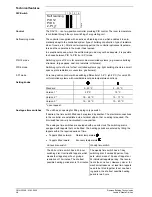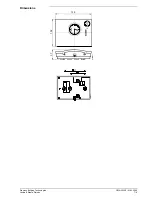
CE1N2226E / 01.02.2000
Siemens Building Technologies
4/8
Landis & Staefa Division
1
2
3
PID 12
PID 6
2-Pt
22
24Z
01
Self learning
4
The RAV12… is a two-position controller providing PID control. The room temperature
is controlled through the cyclic switching of a regulating unit..
The controller is supplied with an active self-learning mode, which enables it to auto-
matically adapt to the controlled system (type of building construction, type of radiators,
size of rooms, etc.). After a certain learning period, the controller optimises its parame-
ters and then operates in the mode it has learned.
In exceptional cases, where the self-learning mode may not be adequate, it is possible
to choose between PID 12, PID 6 or 2-Pt mode:
Switching cycle of 12 min for normal or slow controlled systems (e.g. massive building
structures, large spaces, cast-iron radiators, oil burners).
Switching cycle of 6 min for fast controlled systems (e.g. light building structures, small
spaces, plate radiators or convectors, gas burners).
Pure two-position control with a switching differential of 0.5 °C (±0.25 °C) for very diffi-
cult controlled systems with considerable outside temperature variations.
Standard
5…30 °C
5…30 °C
Version 1 *
20 °C
15 °C
Version 2 *
18…22 °C
13…17 °C
Version 3 *
15…25 °C
10…20 °C
* upon request
The unit has an opening for fitting a plug-in type switch.
If desired, the time switch fitted can be replaced by another. The electrical connections
to the controller are established via a terminal strip so that no wiring is required.
The
time switches can only be mounted in one position.
The analogue time switches are equipped with a quartz clock The switching dial is
equipped with tappets that can be tilted. The heating periods are entered by tilting the
tappets within the required period of time:
•
Tappets tilted outward:
Normal temperature
•
Tappets tilted inward:
Economy temperature
24-hour time switch
Weekly time switch
The 24-hour time switch has a 24-hour
switching dial. It carries 96 tappets, which
means four tappets per hour, giving a
resolution of 15 minutes. The shortest
possible heating period also is 15 minutes.
The weekly time switch has a 7-day
switching dial. It carries 84 pairs of tap-
pets, which means 12 pairs of tappets or
24 individual tappets per day. The resolu-
tion is thus one hour. However, since - for
mechanical reasons - at least two tappets
need to be tilted together to set one heat-
ing period, the shortest possible heating
period is two hours.
Technical features
DIP-Switch
Control
Self-learning mode
PID 12 mode
PID 6 mode
2-Pt mode
Setting knobs
Analogue time switches


























